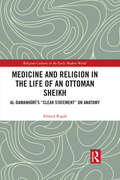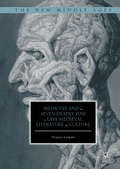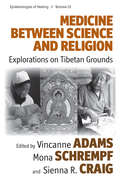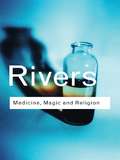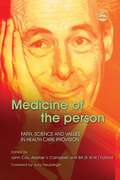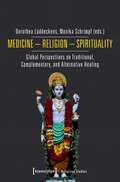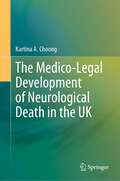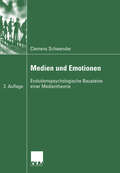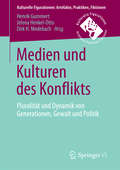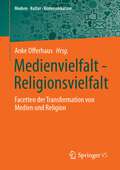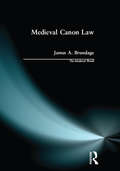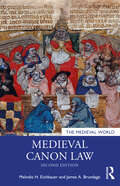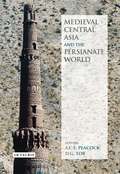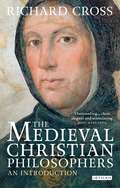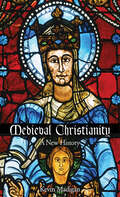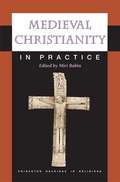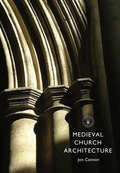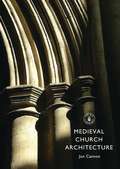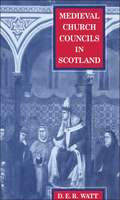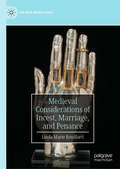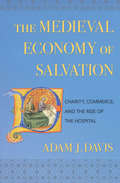- Table View
- List View
Medicine and Religion in the Life of an Ottoman Sheikh: Al-Damanhuri’s "Clear Statement" on Anatomy (Religious Cultures in the Early Modern World)
by Ahmed RagabIn 1768, Aḥmad al-Damanhūrī became the rector (shaykh) of al-Azhar, which was one of the most authoritative and respected positions in the Ottoman Empire. He occupied this position until his death. Despite being a prolific author, whose writings are largely extant, al-Damanhūrī remains almost unknown, and much of his work awaits study and analysis. This book aims to shed light on al-Damanhūrī’s diverse intellectual background, and that of and his contemporaries, building on and continuing the scholarship on the academic thought of the late Ottoman Empire. The book specifically investigates the intersection of medical and religious knowledge in Eighteenth-Century Egypt. It takes as its focus a manuscript on anatomy by al-Damanhūrī (d. 1778), entitled "The Clear Statement on the Science of Anatomy (al-qawl al-ṣarīḥ fī ʿilm al-tashrīḥ),". The book includes an edited translation of The Clear Statement, which is a well-known but unstudied and unpublished manuscript. It also provides a summary translation and analysis of al-Damanhūrī’s own intellectual autobiography. As such, the book provides an important window into a period that remains deeply understudied and a topic that continues to cause debates and controversies. This study, therefore, will be of keen interest to scholars working on the "post-Classical" Islamic world, as well as historians of religion, science, and medicine looking beyond Europe in the Early Modern period.
Medicine and Religion in the Life of an Ottoman Sheikh: Al-Damanhuri’s "Clear Statement" on Anatomy (Religious Cultures in the Early Modern World)
by Ahmed RagabIn 1768, Aḥmad al-Damanhūrī became the rector (shaykh) of al-Azhar, which was one of the most authoritative and respected positions in the Ottoman Empire. He occupied this position until his death. Despite being a prolific author, whose writings are largely extant, al-Damanhūrī remains almost unknown, and much of his work awaits study and analysis. This book aims to shed light on al-Damanhūrī’s diverse intellectual background, and that of and his contemporaries, building on and continuing the scholarship on the academic thought of the late Ottoman Empire. The book specifically investigates the intersection of medical and religious knowledge in Eighteenth-Century Egypt. It takes as its focus a manuscript on anatomy by al-Damanhūrī (d. 1778), entitled "The Clear Statement on the Science of Anatomy (al-qawl al-ṣarīḥ fī ʿilm al-tashrīḥ),". The book includes an edited translation of The Clear Statement, which is a well-known but unstudied and unpublished manuscript. It also provides a summary translation and analysis of al-Damanhūrī’s own intellectual autobiography. As such, the book provides an important window into a period that remains deeply understudied and a topic that continues to cause debates and controversies. This study, therefore, will be of keen interest to scholars working on the "post-Classical" Islamic world, as well as historians of religion, science, and medicine looking beyond Europe in the Early Modern period.
Medicine and the Seven Deadly Sins in Late Medieval Literature and Culture (The New Middle Ages)
by Virginia LangumThis book considers how scientists, theologians, priests, and poets approached the relationship of the human body and ethics in the later Middle Ages. Is medicine merely a metaphor for sin? Or can certain kinds of bodies physiologically dispose people to be angry, sad, or greedy? If so, then is it their fault? Virginia Langum offers an account of the medical imagery used to describe feelings and actions in religious and literary contexts, referencing a variety of behavioral discussions within medical contexts. The study draws upon medical and theological writing for its philosophical basis, and upon more popular works of religion, as well as poetry, to show how these themes were articulated, explored, and questioned more widely in medieval culture.
Medicine Between Science and Religion: Explorations on Tibetan Grounds (Epistemologies of Healing #10)
by Vincanne Adams, Mona Schrempf and Sienna R. CraigThere is a growing interest in studies that document the relationship between science and medicine - as ideas, practices, technologies and outcomes - across cultural, national, geographic terrain. Tibetan medicine is not only known as a scholarly medical tradition among other Asian medical systems, with many centuries of technological, clinical, and pharmacological innovation; it also survives today as a complex medical resource across many Asian nations - from India and Bhutan to Mongolia, Tibet (TAR) and China, Buryatia - as well as in Western Europe and the Americas. The contributions to this volume explore, in equal measure, the impacts of western science and biomedicine on Tibetan grounds - i.e., among Tibetans across China, the Himalaya and exile communities as well as in relation to globalized Tibetan medicine - and the ways that local practices change how such “science” gets done, and how this continually hybridized medical knowledge is transmitted and put into practice. As such, this volume contributes to explorations into the bi-directional flows of medical knowledge and practice.
Medicine, Magic and Religion
by W.H.R. RiversOne of the most fascinating men of his generation, W.H.R. Rivers was a British doctor and psychiatrist as well as a leading ethnologist. Immortalized as the hero of Pat Barker's award-winning Regeneration trilogy, Rivers was the clinician who, in the First World War, cared for the poet Siegfried Sassoon and other infantry officers injured on the western front. His researches into the borders of psychiatry, medicine and religion made him a prominent member of the British intelligentsia of the time, a friend of H.G. Wells, George Bernard Shaw and Bertrand Russell. Part of his appeal lay in an extraordinary intellect, mixed with a very real interest in his fellow man. Medicine, Magic and Religion is a prime example of this. A social institution, it is one of Rivers' finest works. In it, Rivers introduced the then revolutionary idea that indigenous practices are indeed rational, when viewed in terms of religious beliefs.
Medicine, Magic and Religion
by W.H.R. RiversOne of the most fascinating men of his generation, W.H.R. Rivers was a British doctor and psychiatrist as well as a leading ethnologist. Immortalized as the hero of Pat Barker's award-winning Regeneration trilogy, Rivers was the clinician who, in the First World War, cared for the poet Siegfried Sassoon and other infantry officers injured on the western front. His researches into the borders of psychiatry, medicine and religion made him a prominent member of the British intelligentsia of the time, a friend of H.G. Wells, George Bernard Shaw and Bertrand Russell. Part of his appeal lay in an extraordinary intellect, mixed with a very real interest in his fellow man. Medicine, Magic and Religion is a prime example of this. A social institution, it is one of Rivers' finest works. In it, Rivers introduced the then revolutionary idea that indigenous practices are indeed rational, when viewed in terms of religious beliefs.
Medicine of the Person: Faith, Science and Values in Health Care Provision (PDF)
by Ahmed Okasha Alastair Campbell Andrew Sims Bernard Ruedi Claire Hilton Dinesh Bhugra Hans-Rudolf Pfeifer John Clark John Cox Julia Neuberger Martin Conway Michael Hilton Mike Magee Peter Gilbert Robert Atwell Thierry Collaud Tom Fryers Bill K. W. M. FulfordMedicine of the Person is an international, multi-faith exploration of the demonstrable need to integrate the scientific basis of healthcare more fully with spiritual, religious and ethical values. Informed by the principle of 'medicine of the person', the contributors argue for a medical practice which takes account of personal relationships, spirituality, ethics and theology in keeping with the ideas and beliefs of Paul Tournier, an influential Swiss general practitioner whose thinking has had a substantial impact on routine patient care relevant to national health services. Bridging the gap between the basic sciences and faith traditions, the contributors discuss notions of personhood in different faiths and its consideration in spirituality and mental health issues, general practice issues, public health, home care for the elderly and neuroscience. This volume offers a broad spectrum of approaches to the needs of patients and is a key text for students of the health disciplines, and practitioners and managers in these fields.
Medicine - Religion - Spirituality: Global Perspectives on Traditional, Complementary, and Alternative Healing (Religionswissenschaft #13)
by Dorothea Lüddeckens Monika SchrimpfIn modern societies the functional differentiation of medicine and religion is the predominant paradigm. Contemporary therapeutic practices and concepts in healing systems, such as Transpersonal Psychology, Ayurveda, as well as Buddhist and Anthroposophic medicine, however, are shaped by medical as well as religious or spiritual elements. This book investigates configurations of the entanglement between medicine, religion, and spirituality in Europe, Asia, North America, and Africa. How do political and legal conditions affect these healing systems? How do they relate to religious and scientific discourses? How do therapeutic practitioners position themselves between medicine and religion, and what is their appeal for patients?
The Medico-Legal Development of Neurological Death in the UK
by Kartina A. ChoongDiagnosis of death by neurological criteria (DNC) is a construct which has been part of the British medico-legal landscape for nearly half a century. This book examines the factors behind its emergence, and discusses the various changes that took place in the last few decades that culminated in the current definition and clinical criteria for determining brain-based death. It highlights the continuities and discontinuities in practice, and the impact they have on the issue of withdrawal of mechanical ventilation in intensive care units and on the field of organ transplantation. The book also explores the law’s response to the introduction and development of DNC in clinical practice. It demonstrates how the legitimacy of the definition and criteria used by the medical profession were forged in the courtroom rather than in Parliament. It documents why case law were introduced in court, and assesses whether organ donation was a consideration in the deliberations. It will be emphasised that courts have given insufficient consideration to requests made in recent cases to consider a broader range of methods to determine death. Those pleas were made on the grounds that the definition and criteria used in the UK are dissimilar to those used in other jurisdictions that also adopt DNC; and that faith communities have a different understanding of death. By taking a close look at those other approaches before highlighting the inherent limitations of the courtroom as the forum that confers DNC its legitimacy, the book puts forward the argument that the democratic process should be engaged.
Medien und Emotionen: Evolutionspsychologische Bausteine einer Medientheorie
by Clemens SchwenderClemes Schwender nutzt die Erkenntnisse der Evolutionspsychologie, um die Frage zu beantworten, warum die Menschen so viel Zeit mit Medien verbringen.
Medien und Kulturen des Konflikts: Pluralität und Dynamik von Generationen, Gewalt und Politik (Kulturelle Figurationen: Artefakte, Praktiken, Fiktionen)
by Henrik Gummert Jelena Henkel-Otto Dirk H. MedebachDer Sammelband beruht auf der Annahme, dass Medientechnologien, Medienpraktiken sowie Medienbilder und die Konstitution und Vermittlung sozialer Realität in einem reziproken Verhältnis zueinander stehen. Es werden kulturell-normative Deutungsmuster sowie Rezeptionspraktiken transportiert, die weitgehende Implikationen auf Gesellschaft haben. Digitale Informations- und Kommunikationstechnologien erweitern mediale Darstellungen, Diskurse und Verhandlungen sozialer Konflikte. Im Zuge dessen werden gleichsam private Konflikte, das Konflikthandeln selbst, zunehmend medienvermittelt. Entsprechende kulturelle Aneignungs- und Rezeptionsprozesse von Akteuren führen zu neuen Konfliktfigurationen. Die dabei entstehenden Konfliktformen werden in unterschiedlichen Massenmedien aufgegriffen, was eine intermediale Komponente von Konfliktkommunikation zum Ausdruck bringt.
Medienvielfalt - Religionsvielfalt: Facetten der Transformation von Medien und Religion (Medien • Kultur • Kommunikation)
by Anke OfferhausAusgehend von der kommunikativen Konstruktion von Religion analysiert der Band die grundlegende Fragen, welchen Stellenwert Medien für die Konstruktion religiöser sozialer Wirklichkeiten haben und in welchem Verhältnis dabei Medienwandel und der Wandel von Religion stehen. Der interdisziplinäre Sammelband zielt vor dem Hintergrund des Mediatisierungsansatzes auf die Zusammenführung der bislang wechselseitig wenig zur Kenntnis genommenen sozialwissenschaftlichen Forschungen renommierter deutschsprachiger Wissenschaftler/innen. Darüber hinaus widmet er sich einem in allen Disziplinen bislang wenig diskutiertem Zusammenhang, nämlich dem Verhältnis von Medien und Religion im sozialen Wandel.
Medieval Canon Law (The Medieval World)
by James A BrundageIt is impossible to understand how the medieval church functioned -- and in turn influenced and controlled the lay world within its care -- without understanding the development, character and impact of `canon law', its own distinctive law code. However important, this can seem a daunting subject to non-specialists. They have long needed an attractive but authoritative introduction, avoiding arid technicalities and setting the subject in its widest context. James Brundage's marvellously fluent and accessible book is the perfect answer: it will be warmly welcomed by medievalists and students of ecclesiastical and legal history.
Medieval Canon Law (The Medieval World)
by James A BrundageIt is impossible to understand how the medieval church functioned -- and in turn influenced and controlled the lay world within its care -- without understanding the development, character and impact of `canon law', its own distinctive law code. However important, this can seem a daunting subject to non-specialists. They have long needed an attractive but authoritative introduction, avoiding arid technicalities and setting the subject in its widest context. James Brundage's marvellously fluent and accessible book is the perfect answer: it will be warmly welcomed by medievalists and students of ecclesiastical and legal history.
Medieval Canon Law (The Medieval World)
by James A. Brundage Melodie H. EichbauerIt is impossible to understand how the medieval church functioned and, in turn, influenced the lay world within its care without understanding "canon law". This book examines its development from its beginnings to the end of the Middle Ages, updating its findings in light of recent scholarly trends. This second edition has been fully revised and updated by Melodie H. Eichbauer to include additional material on the early Middle Ages; the significance of the discovery of earlier versions of Gratian’s Decretum; and the new research into law emanating from secular authorities, councils, episcopal acta, and juridical commentary to rethink our understanding of the sources of law and canon law's place in medieval society. Separate chapters examine canon law in intellectual spaces; the canonical courts and their procedures; and, using the case studies of deviation from orthodoxy and marriage, canon law in the lives of people. The main body of the book concludes with the influence of canon law in Western society, but has been reworked by integrating sections cut from the first edition chapters on canon law in private and public life to highlight the importance of this field of research. Throughout the work and found in the bibliography are references to current literature and resources in order to make researching in the field more accessible. The first appendix provides examples of how canonical texts are cited while the second offers biographical notes on canonists featured in the work. The end result is a second edition that is significantly rewritten and updated but retains the spirit of Brundage’s original text. Covering all aspects of medieval canon law and its influence on medieval politics, society, and culture, this book provides students of medieval history with an accessible overview of this foundational aspect of medieval history.
Medieval Canon Law (The Medieval World)
by James A. Brundage Melodie H. EichbauerIt is impossible to understand how the medieval church functioned and, in turn, influenced the lay world within its care without understanding "canon law". This book examines its development from its beginnings to the end of the Middle Ages, updating its findings in light of recent scholarly trends. This second edition has been fully revised and updated by Melodie H. Eichbauer to include additional material on the early Middle Ages; the significance of the discovery of earlier versions of Gratian’s Decretum; and the new research into law emanating from secular authorities, councils, episcopal acta, and juridical commentary to rethink our understanding of the sources of law and canon law's place in medieval society. Separate chapters examine canon law in intellectual spaces; the canonical courts and their procedures; and, using the case studies of deviation from orthodoxy and marriage, canon law in the lives of people. The main body of the book concludes with the influence of canon law in Western society, but has been reworked by integrating sections cut from the first edition chapters on canon law in private and public life to highlight the importance of this field of research. Throughout the work and found in the bibliography are references to current literature and resources in order to make researching in the field more accessible. The first appendix provides examples of how canonical texts are cited while the second offers biographical notes on canonists featured in the work. The end result is a second edition that is significantly rewritten and updated but retains the spirit of Brundage’s original text. Covering all aspects of medieval canon law and its influence on medieval politics, society, and culture, this book provides students of medieval history with an accessible overview of this foundational aspect of medieval history.
Medieval Central Asia and the Persianate World: Iranian Tradition and Islamic Civilisation (British Institute of Persian Studies)
by D.G. Tor A.C.S. PeacockFrom the political dissolution of the Abbasid Caliphate in the mid-ninth century to the beginning of the thirteenth century, the Persianate dynasties of Islamic Central Asia constituted the political and military stronghold of Sunni Islam. It was in this region, historically known as Khurasan and Transoxiana, that many of the important religious and cultural developments of Islamic civilisation took place. The region first gave rise to the Abbasid Revolution, provided the troops for its success, and supplied the military slaves and auxiliaries that led to its political dissolution. From the second part of the ninth century and for the ensuing 400 years, the Sunni Persianate dynasties formed the mainstay of Islamic military might over the Islamic heartland, from India to Egypt. The period was also characterised by the cultural dominance of the Persian-speaking court, bringing about the acceptance of classical Persian as the second primary Islamic language of high culture. It produced the writing of many of Islamic civilisation's greatest works of poetry, philosophy, biography, history, belles-lettres and religion, in both Arabic and Persian. This volume explores the origins and nature of this cultural and political authority and sheds light on one of the most formative yet unexplored eras of Islamic history.
The Medieval Christian Philosophers: An Introduction (Library of Medieval Studies)
by Richard CrossThe High Middle Ages were remarkable for their coherent sense of 'Christendom': of people who belonged to a homogeneous Christian society marked by uniform rituals of birth and death and worship. That uniformity, which came under increasing strain as national European characteristics became more pronounced, achieved perhaps its most perfect intellectual expression in the thought of the western Christian thinkers who are sometimes called 'scholastic theologians'. These philosophers produced (during roughly the period 1050-1350 CE) a cohesive body of work from their practice of theology as an academic discipline in the university faculties of their day. Richard Cross' elegant and stylish textbook - designed specifically for modern-day undergraduate use on medieval theology and philosophy courses - offers the first focused introduction to these thinkers based on the individuals themselves and their central preoccupations. The book discusses influential figures like Abelard, Peter Lombard and Hugh of St Victor; the use made by Aquinas of Aristotle; the mystical theology of Bonaventure; Robert Grosseteste's and Roger Bacon's interest in optics; the complex metaphysics of Duns Scotus; and the political thought of Marsilius of Padua and William of Ockham. Key themes of medieval theology, including famous axioms like 'Ockham's Razor', are here made fully intelligible and transparent.
Medieval Christianity: A New History
by Kevin MadiganFor many, the medieval world seems dark and foreign—a miraculous, brutal, and irrational time of superstition and strange relics. The pursuit of heretics, the Inquisition, the Crusades and the domination of the “Holy Land” come to mind. Yet the medieval world produced much that is part of our world today, including universities, the passion for Roman architecture and the emergence of the gothic style, pilgrimage, the emergence of capitalism, and female saints. This new narrative history of medieval Christianity, spanning from A.D. 500 to 1500, attempts to combine both what is unfamiliar and what is familiar to readers. Elements of novelty in the book include a steady focus on the role of women in Christianity; the relationships among Christians, Jews, and Muslims; the experience of ordinary parishioners; the adventure of asceticism, devotion and worship, and instruction through drama, architecture, and art. Madigan expertly integrates these areas of focus with more traditional themes, such as the evolution and decline of papal power, the nature and repression of heresy, sanctity and pilgrimage, the conciliar movement, and the break between the old Western church and its reformers. Illustrated with more than forty photographs of physical remains, this book promises to become an essential guide to a historical era of profound influence.
Medieval Christianity in Practice (Princeton Readings in Religions #36)
by Miri RubinMedieval Christianity in Practice provides readers with a sweeping look at the religious practices of the European Middle Ages. Comprising forty-two selections from primary source materials--each translated with an introduction and commentary by a specialist in the field--the collection illustrates the religious cycles, rituals, and experiences that gave meaning to medieval Christian individuals and communities.This volume of Princeton Readings in Religions assembles sources reflecting different genres, regions, and styles, including prayer books, chronicles, diaries, liturgical books, sermons, hagiography, and handbooks for the laity and clergy. The texts represent the practices through which Christians conducted their individual, family, and community lives, and explores such life-cycle events as birth, confirmation, marriage, sickness, death, and burial. The texts also document religious practices related to themes of work, parish life, and devotions, as well as power and authority. Enriched by expert analysis and suggestions for further reading, Medieval Christianity in Practice gives students and general readers alike the necessary background and foundations for an appreciation of the creativity and multiplicity of medieval Christian religious culture.
Medieval Church Architecture (Shire Library)
by Jon CannonBritain is a treasure trove of medieval architecture. Almost every village and town in the land has a church that was built during the period, whose history is legible – to those who know how to look – in every arch, capital, roof vault, and detail of window tracery. By learning how to identify the stylistic phases that resulted from shifts in architectural fashion, it is possible to date each part of a church to within a decade or two; this book introduces all the key features of each succeeding style, from Anglo-Saxon and Norman through to the three great gothic styles, Early English, Decorated and Perpendicular. It will be indispensable to anyone who enjoys exploring medieval churches, and who wants to understand and appreciate their beauty more deeply.
Medieval Church Architecture (Shire Library)
by Jon CannonBritain is a treasure trove of medieval architecture. Almost every village and town in the land has a church that was built during the period, whose history is legible – to those who know how to look – in every arch, capital, roof vault, and detail of window tracery. By learning how to identify the stylistic phases that resulted from shifts in architectural fashion, it is possible to date each part of a church to within a decade or two; this book introduces all the key features of each succeeding style, from Anglo-Saxon and Norman through to the three great gothic styles, Early English, Decorated and Perpendicular. It will be indispensable to anyone who enjoys exploring medieval churches, and who wants to understand and appreciate their beauty more deeply.
Medieval Church Councils in Scotland
by Donald WattUniquely in the kingdoms of western Christendom, the Scottish bishops obtained authority, in 1225, to hold inter-diocesan meetings without a supervisory archbishop, and continued to meet in this way for nearly 250 years. Donald Watt provides an authoritative study of these church councils from the Latin and English records based on original sources.In addition to creating an original work of considerable historical interest, Professor Watt brings discussion of the councils and their significance into the broader context of Scotland's political, legal, ecclesiastical and social situation over a long period.An important contribution to Scottish church history and to its influence on contemporary affairs.
Medieval Considerations of Incest, Marriage, and Penance (The New Middle Ages)
by Linda Marie RouillardMedieval Considerations of Incest, Marriage, and Penance focuses on the incest motif as used in numerous medieval narratives. Explaining the weakness of great rulers, such as Charlemagne, or the fall of legendary heroes, such as Arthur, incest stories also reflect on changes to the sacramental regulations and practices related to marriage and penance. Such changes demonstrate the Church's increasing authority over the daily lives and relationships of the laity. Treated here are a wide variety of medieval texts, using as a central reference point Philippe de Rémi's thirteenth-century La Manekine, which presents one lay author's reflections on the role of consent in marriage, the nature of contrition and forgiveness, and even the meaning of relics. Studying a variety of genres including medieval romance, epic, miracles, and drama along with modern memoirs, films, and novels, Linda Rouillard emphasizes connections between medieval and modern social concerns. Rouillard concludes with a consideration of the legacy of the incest motif for the twenty-first century, including survivor narratives, and new incest anxieties associated with assisted reproductive technology.
The Medieval Economy of Salvation: Charity, Commerce, and the Rise of the Hospital
by Adam J. DavisIn The Medieval Economy of Salvation, Adam J. Davis shows how the burgeoning commercial economy of western Europe in the twelfth and thirteenth centuries, alongside an emerging culture of Christian charity, led to the establishment of hundreds of hospitals and leper houses. Focusing on the county of Champagne, he looks at the ways in which charitable organizations and individuals—townspeople, merchants, aristocrats, and ecclesiastics—saw in these new institutions a means of infusing charitable giving and service with new social significance and heightened expectations of spiritual rewards.In tracing the rise of the medieval hospital during a period of intense urbanization and the transition from a gift economy to a commercial one, Davis makes clear how embedded this charitable institution was in the wider social, cultural, religious, and economic fabric of medieval life.
